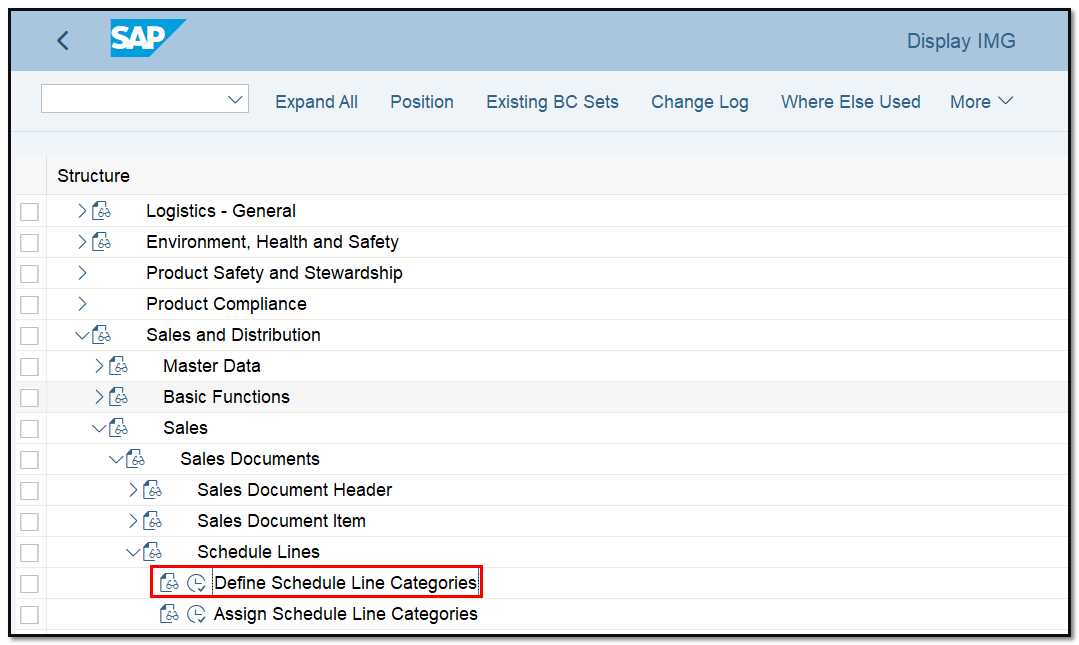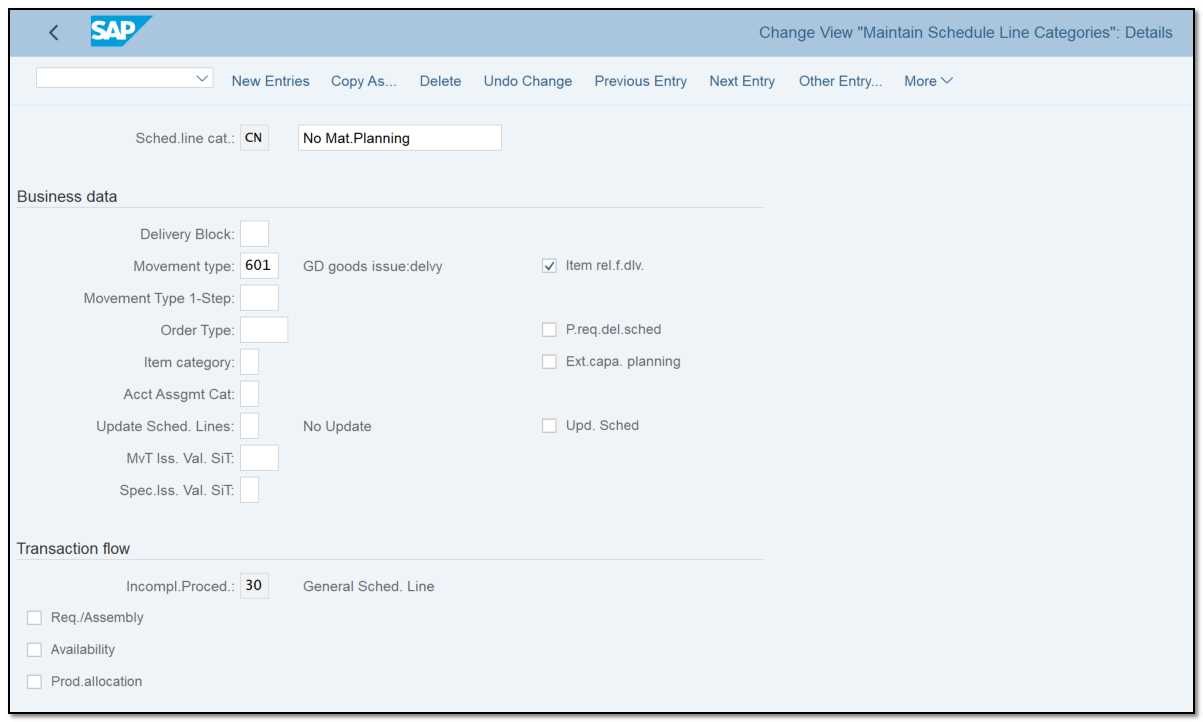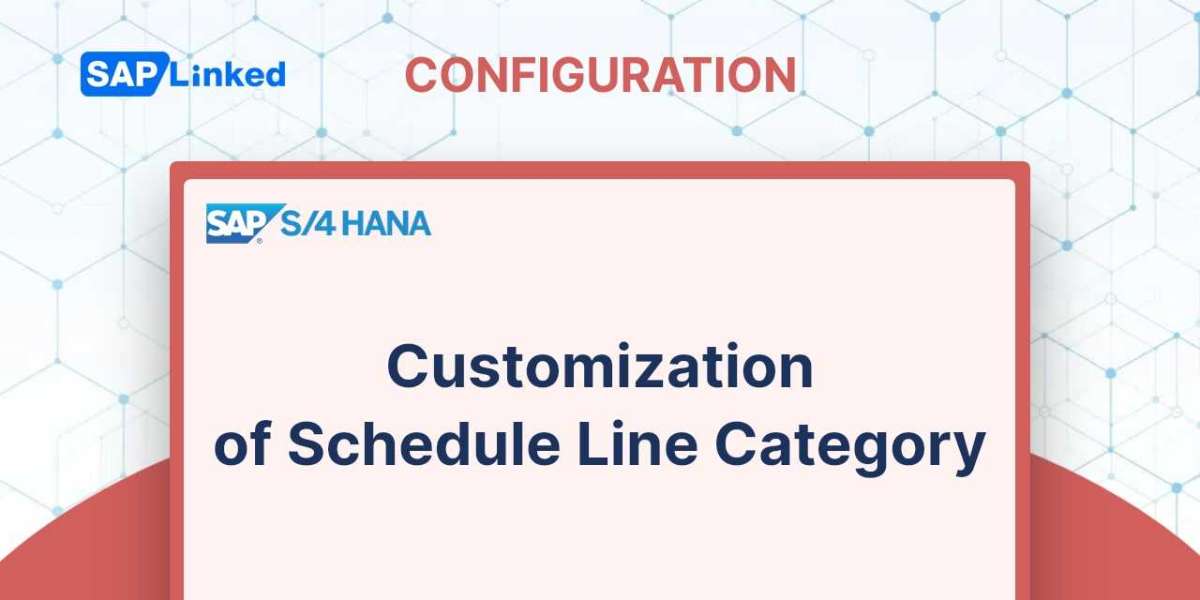There are three levels in a SAP SD sales document: the header, the items, and the schedule lines. Important details like delivery date, quantity confirmed, and quantity delivered are included in each item's SAP SD scheduling line. A schedule line category manages this delivery scheduling process and has an impact on logistics by managing relevant indicators and other values relating to delivery, purchase requisition generation, availability check, goods movement, requirement transfer, product allocation, and MRP applicability for an item.
SAP SD schedule line categories will control several aspects:
1. Whether an item is relevant for delivery.
2.Will be checked for an item's availability.
3.Which movement type will be applied during the delivery process's goods issue and reception.
4.Whether the material is purchased outside the company (by using third party processing).
If you go to the schedule line details, you will find SAP SD schedule line categories assigned to each item.
The configuration options you select when creating the schedule line category determine how a schedule line behaves, including whether to create a delivery, block a delivery by default, permit MRP, and other actions.
A schedule line category is defined in transaction code VOV6 or by following the menu path IMG ➢ Sales And Distribution ➢ Sales ➢ Sales Documents ➢ Schedule Lines ➢ Define Schedule Line Categories.

Figure 1 Menu Path for Schedule Line Category
Select one of the categories and click on “Copy” button.

Figure 2 Defining schedule line categories
Defining your own schedule line category on the customisation screen requires inputting a two-digit alphanumeric key along with a description. When naming your objects, always keep the prefix Z rule in mind. There may be circumstances where you need to develop your own unique schedule line category, even though the standard SAP provides a large variety of schedule line categories.
Let's review a few customization options for a scheduling line category as shown in Figure 3.

Figure 3 Defining schedule line categories
Schedule Line Category Key and Type Figure 1 displays the schedule line category key as CN at the top of the screen and the schedule line category type's description as No MRP.
The schedule line category has two alphabetic keys.
First character of key:
Character | Uses |
A | Inquiry |
B | Quotation |
C | Sales order |
D | Returns |
Second character of key:
Character | Uses |
T | no inventory management |
X | no inventory management with goods issue |
N | no planning |
P | MRP |
V | consumption-based planning |
A few of them are utilized by the majority of transactions, as seen in the table below.
Schedule Line Category | Functionality |
AT | For the schedule line type under consideration, there is no availability check or delivery relevance; it is solely used for information. |
BN | There is no availability check, MRP, or delivery-related information in the quotation. |
CP | The requirement will be moved, the availability check is active, and it is pertinent for delivery; the movement type is 601 |
CV | Although there is no availability check and MRP is active, the demand will still be sent for review. |
DN | This schedule line is only used for return documents and will post goods receipts with movement type 651. |
Delivery Block It instantly becomes the default delivery block on the schedule line in the sales document when you provide a delivery block key in this field. Select the delivery block that you wish to be the default for your scheduling lines.
Movement Type In SAP, a movement type controls how products are moved "to and from," which controls how the inventory is updated. For instance, movement type 601 reduces inventory to the extent of provided quantities when products are issued from inventory. The movement of items between 601 and 699 is used by the SD module. Select the movement type that best fits your schedule line category here.
Item Relevant For Delivery Indicator enables the scheduling line's linked items to be relevant for delivery when chosen. Leave this field deselected if you don't want the items delivered for scheduling line types connected to inquiries and quotes.
Movement Type 1-Step In this field, you can enter the movement type for a one-step product movement. Both one-step and two-step movements of items are possible with processes like STO.
Order Type/Item Category/Account Assignment Category You may verify the stock levels of the items using ATP checks and TOR, and you can send any shortage requirements to the PP or Purchasing module for use in production planning or procurement. When these three data are combined, a purchase requisition can be automatically created for the requirements that were transferred from a sales order.
Purchase Requisition Delivery Schedule If the sales line item is applicable for delivery rescheduling, it is indicated by a checkbox. Because it is possible to have a direct shipment of goods from your vendor to your client, you do not need SAP to modify the delivery dates in such a case. Therefore, keep this deselected for processing third-party orders. Use this so that SAP can include such periods in the delivery scheduling when the products arrive at your warehouse first and are transferred to a customer's purchase order once the requirements from the sales order are received.
Update Schedule Lines from External Procurement Controls Whether you enter a shipment notification for the associated individual purchase order or when you post the relevant goods receipt, the system will immediately update the scheduling lines of a sales order item.
Update Schedule Line from Purchase Order If the associated purchase order (PO) changes, you can use this flag to cause the modification of a sales order schedule line.
Movement Type for Issuing Valuated Stock in Transit provides a kind of goods movement, which is based on the issuing valued stock in transit. Each goods movement in the system is given a movement type.
You can configure the following goods movements and transfers of title for the stock transfer and purchasing procedure in the Customizing activity.
Define Schedule Line Categories, depending on valuated stock in transit:
- Transfers of stock involving valuated cross-company stock in transit (CST)
Default schedule line categories N2 and N3:
The movement type 685 (Stock transfer from issuing valuated CST) is the default follow-on movement type for the 681 (Stock Transfer to Issuing Valuated Cross-Company-Code Stock in Transit (CST)) in the Movement Type for Issuing Valuated Stock in Transit field. To identify the precise transfer of title, use the Specification for Issuing Valuated Stock in Transit field:
- Transfer of title on goods receipt (schedule line category N2)
- Transfer of title during transit (schedule line category N3)
Only movement type 683 (Stock transfer to receiving valued CST), which is the default schedule line category N1's, specifies that the transfer of title is on goods issue.
•Stock transfers with valuated intra-company-code stock in transit (IST)
Default schedule line categories N5 and N6:
The 68A (Stock Transfer to Issuing Valuated Intra-Company-Code Stock in Transit (IST)) default follow-on movement type is defined as follows:
- Transfer of title on goods reception - movement type 681 (Stock Transfer from Issuing IST to Receiving Plant)(schedule line category N5)
- Title transfer during transit - movement type 68E (Stock Transfer from Issuing IST to Receiving Valuated IST)(schedule line category N6)
The Specification for Issuing Valuated Stock in Transit field does not need to be filled out for intra-company-code stock transactions.
Only movement type 68C (Stock transfer to receiving valued IST) for default schedule line category N4 specifies that transfer of title is on goods issue.
- Delivery to customers with valuated stock in transit
Default schedule line category NU:
Specification for Issuing Valuated Stock in Transit In conjunction with the Movement Type for Issuing Valuable Stock in Transit Customizing field, specifies the precise transfer of title for goods movements containing issuing valued stock in transit.
Depending on issuing valued stock in transit, you can establish the following transfers of title for the stock transfer and purchasing process:
- Issuing valuated CST (cross-company-code stock in transit): You decide whether title is transferred while the goods are in route or when they are received (mandatory entry).
- Issuing valuated IST (intra-company-code stock in transit): You decide whether title is transferred while the goods are in route or when they are received (optional entry).
- Issuing valuated stock in transit in purchasing process with acceptance at origin: You specify that the client site is where the transfer of title takes place (mandatory entry).
Incompletion Procedure field in the customization screen for schedule line categories is for display only. In the customization of incompletion procedures, you enter a default value for an incompletion process for a schedule line.
Req./Assembly This checkbox serves as a toggle switch for requirements transfer. When chosen, the relevant purchase order or purchase requisition can be created in order to transmit the needs from a sales order to the PP or the Purchasing module. Additionally, it serves as a requirement for an availability check to take place. The check won't work if you only choose the availability option and leave the requirement field empty.
Availability/Prod. Allocation when selected, enables the sales order's availability check and product allocation.
Once you modified all data, press Enter and a new pop up will be shown. If you want to transfer the copy control from the original schedule line category, select "Yes."
You might be prompted to make a new change request, depending on the type of system-client you are. You might be prompted to make a new change request, depending on the type of system-client you are.

Figure 4 A Confirmation Dialog Screen Asking for Copy Control Relevancy
Setting Up a Schedule Line Category Determination
Schedule line categories are also created automatically by SAP, like an item category. This is made possible by combining the item categories and MRP type with the schedule line categories. The MRP type manages the requirement planning for the material and is kept in the MRP view of the material master record. A scheduling line category can be assigned via transaction code VOV5 or via menu path
IMG ➢ Sales And Distribution ➢ Sales ➢ Sales Documents ➢ Schedule Lines ➢ Assign Schedule Line Categories.
The customization page for determining a schedule line category is shown in Figure 5. As you can see on this screen, item category TAN (Standard Item And MRP Type ND - No Planning) is given the default schedule line category CN. For your determination rule, you can also add three more manual schedule line categories (field MSLCa). If the material master for a sales order has the MRP type ND and the material line has the item category TAN, SAP will automatically assign the schedule line category of CN to the order. The three manual schedule line category values that you selected when configuring for schedule line category determination can subsequently be used to replace it.

Figure 5 Assigning schedule line categories



